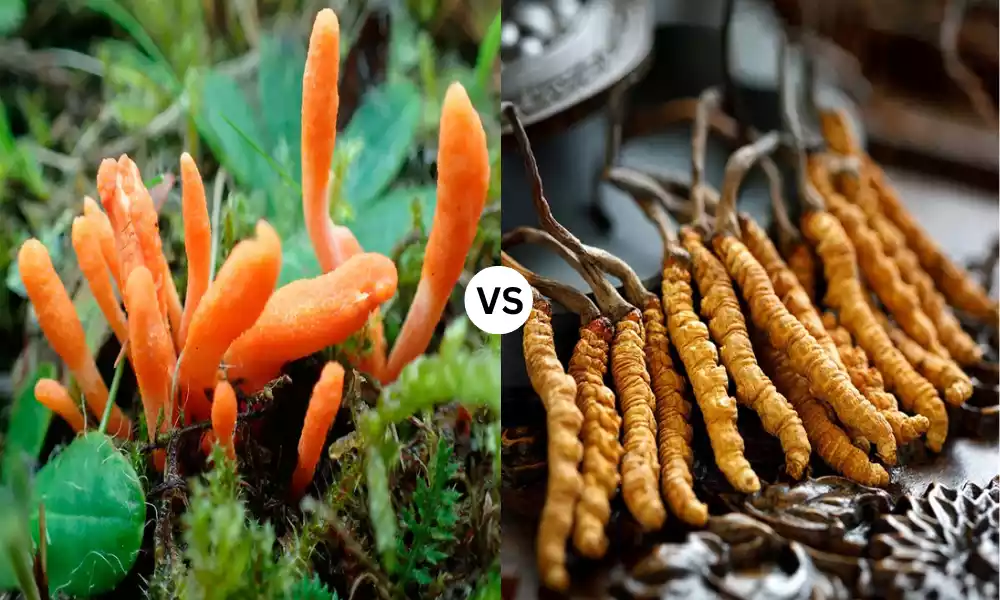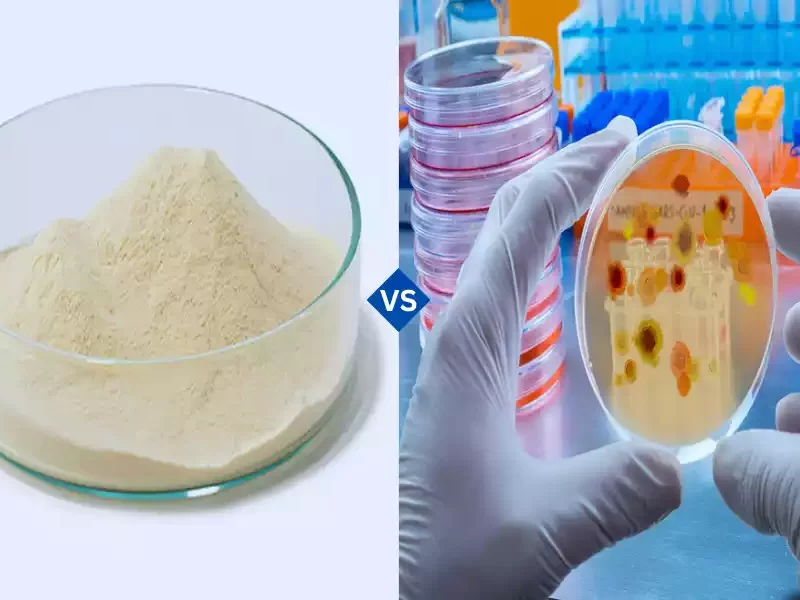Cordyceps is a fascinating genus of parasitic fungi, and among its species, Cordyceps Militaris and Cordyceps Sinensis stand out due to their significant medicinal attributes. Historically rooted in traditional Chinese and Tibetan medicine, Cordyceps Sinensis, often referred to as the “caterpillar fungus,” thrives at high altitudes in the Himalayan region, parasitizing on moth caterpillars. On the other hand, Cordyceps Militaris, recognized by its vibrant orange hue, has a broader distribution, attacking various insects across different continents.
Both these species have garnered attention for their potential health benefits, from boosting energy to supporting immune function, making them prized commodities in the world of natural remedies.
What is Cordyceps Militaris?
Cordyceps Militaris is a species of entomopathogenic fungus, meaning it parasitizes and eventually kills its insect hosts. Recognized by its striking orange or bright red fruiting body, this fungus mainly targets pupae and larvae of various insects, especially those of Lepidoptera (butterflies and moths). Beyond its natural role, Cordyceps Militaris is renowned for its medicinal properties and has been utilized in traditional medicine for centuries.
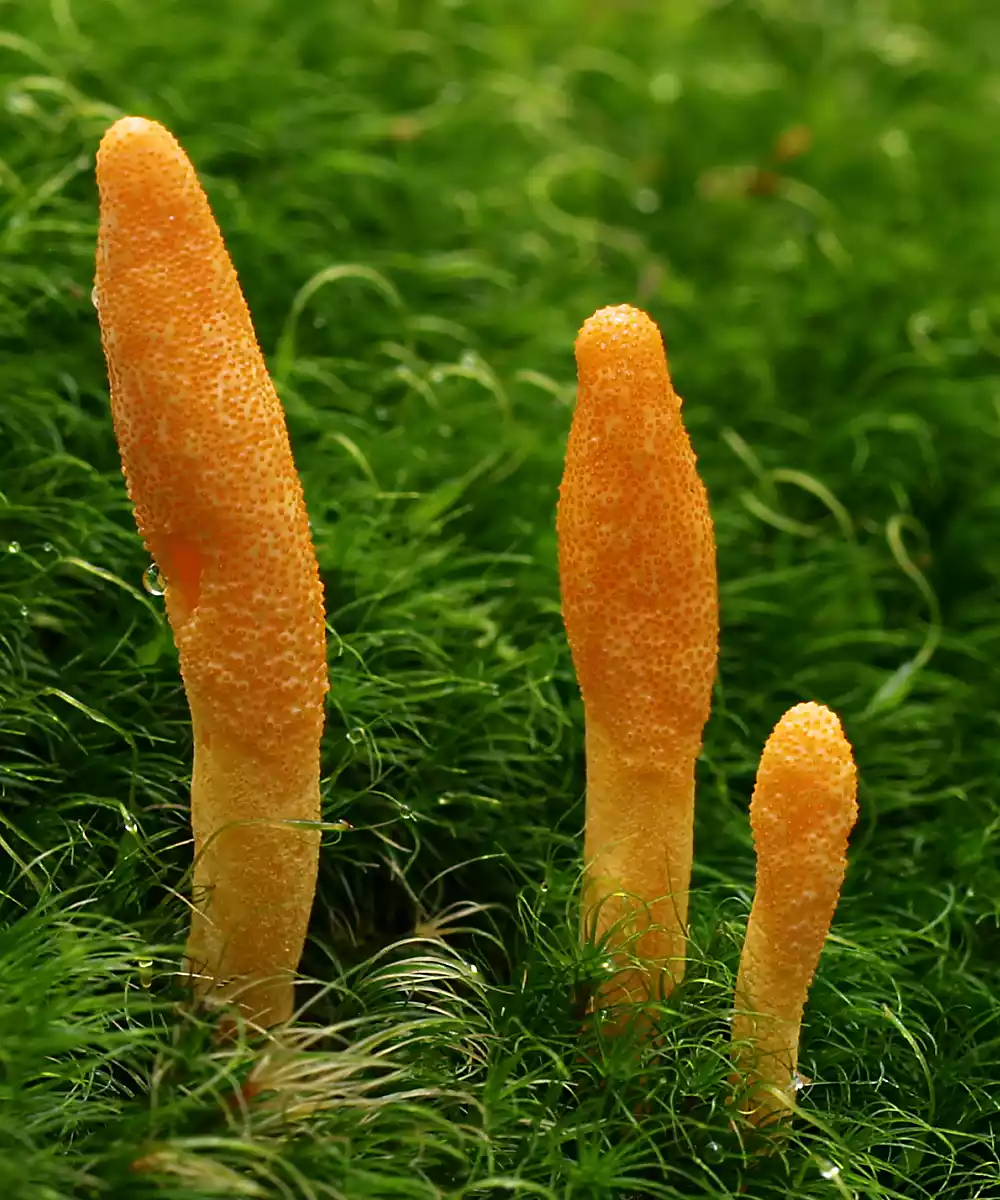
Recent research has highlighted its potential benefits, including anti-inflammatory, antioxidant, and anti-tumor properties, among others. Its ability to be cultivated more easily than some other Cordyceps species has made it a focus for commercial production and pharmaceutical research.
Identification and Appearance
Identification and Appearance of Cordyceps Militaris:
1. Fruiting Body Color:
- Cordyceps Militaris is easily recognizable by its bright orange to red-orange fruiting body, which makes it distinct from many other fungi.
2. Morphology:
- It usually presents a single, club-shaped or cylindrical stalk. The fruiting body is erect, and its surface can range from smooth to slightly wrinkled.
3. Size:
- Typically, the fruiting body of Cordyceps Militaris ranges in size from 1 to 5 cm in length.
4. Host Remains:
- Beneath the fungal stalk, one can often find the mummified remains of the insect (often a pupa or larva) on which the fungus grew. The fungus effectively replaces the host tissue with its own.
5. Growth Habitat:
- Cordyceps Militaris parasitizes various insects, particularly those belonging to the Lepidoptera order (like butterflies and moths). However, it’s known to target a broader range of insects compared to Cordyceps Sinensis.
6. Spore Structure:
- When analyzed under a microscope, Cordyceps Militaris has unicellular, hyaline, and elliptical spores. This feature can be crucial for accurate identification in a scientific context.
7. Sensory Characteristics:
- The fungus has a mild, slightly sweet aroma and can be bitter to taste.
In addition to these features, it’s worth noting that Cordyceps Militaris’ ability to be cultivated more efficiently than Cordyceps Sinensis has led to its widespread commercial cultivation. This means many of the “Cordyceps” supplements or products on the market, especially those produced on a large scale, are derived from Cordyceps Militaris.
Benefits and Medicinal Uses
Benefits and Medicinal Uses of Cordyceps Militaris:
- Energy and Stamina Boost:
- Traditional use supports Cordyceps Militaris as an adaptogen, helping to increase energy levels and stamina. It’s especially favored by athletes for enhancing physical performance.
- Anti-tumor Properties:
- Some studies suggest that Cordyceps Militaris exhibits anti-tumor effects due to its ability to inhibit cell proliferation and induce tumor cell death.
- Antioxidant Properties:
- The fungus contains antioxidants which can help neutralize harmful free radicals, potentially protecting cells from oxidative stress and associated diseases.
- Immunomodulatory Effects:
- Cordyceps Militaris has shown to stimulate the activity of certain immune cells, potentially aiding in the body’s defense against pathogens and diseases.
- Aphrodisiac and Reproductive Health:
- Traditionally, it has been used as an aphrodisiac, and some research supports its role in improving reproductive function and sexual health.
- Anti-inflammatory Effects:
- Cordyceps Militaris might reduce inflammation by inhibiting the release of specific inflammatory markers.
- Liver Protection:
- Some studies have demonstrated the potential hepatoprotective effect of Cordyceps Militaris, suggesting it might aid in safeguarding the liver from toxins and promoting its healthy function.
- Anti-diabetic Properties:
- There’s preliminary evidence to suggest Cordyceps Militaris can help lower blood sugar levels and improve insulin sensitivity, making it potentially beneficial for diabetics.
- Lung Health:
- Cordyceps Militaris has been linked with improved respiratory function, possibly aiding those with asthma or other respiratory conditions.
- Neuroprotective Properties:
- Preliminary research indicates that Cordyceps Militaris might protect neurons from damage, potentially offering benefits for neurodegenerative diseases.
- Antimicrobial Activity:
- Certain compounds in Cordyceps Militaris have shown to exhibit antimicrobial properties against a range of pathogens.
Remember, while many of these benefits have been studied to some extent, more comprehensive research is needed in many areas to fully understand the scope and mechanism of the potential benefits. Additionally, if someone is considering Cordyceps Militaris as a supplement or treatment, it’s essential to consult with a healthcare professional.
What is Cordyceps Sinensis?
Cordyceps Sinensis is a unique parasitic fungus native to the high-altitude regions of the Tibetan Plateau and Himalayas. Often called the “caterpillar fungus,” it infects and eventually mummifies the larvae of ghost moths, producing a fruiting body that protrudes from the host’s remains. Traditionally revered in Chinese and Tibetan medicine for its purported health benefits, Cordyceps Sinensis is believed to enhance energy, stamina, and lung function, among other effects.
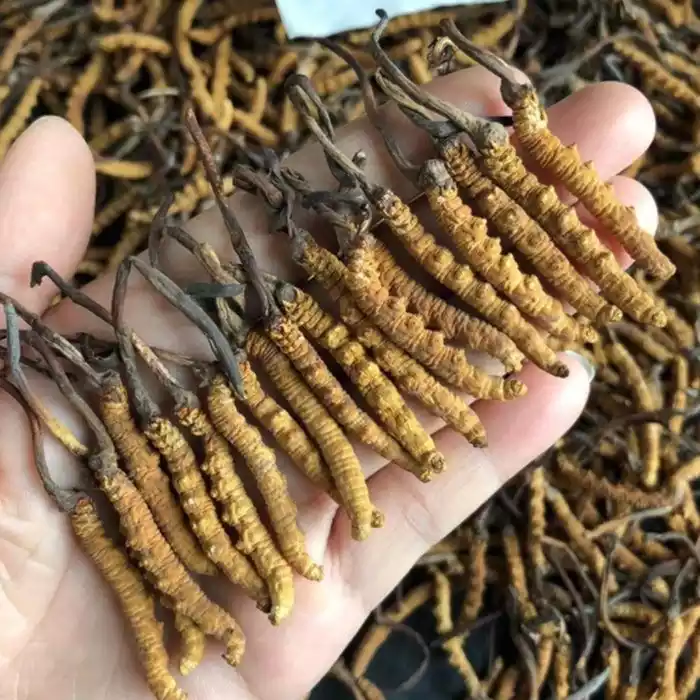
Owing to its high demand and the challenges associated with its cultivation, genuine Cordyceps Sinensis can command a very high market price. The increasing interest in its therapeutic properties has led to extensive scientific research, validating many of its traditional uses.
Distinctive Features
The distinctive features of Cordyceps Sinensis that set it apart from other fungi and particularly from other Cordyceps species are:
- Host Specificity:
- Cordyceps Sinensis specifically infects the larvae of ghost moths. The infected larvae get buried in the alpine soils of the Himalayas before the fungus fully matures.
- Appearance:
- The fruiting body of Cordyceps Sinensis emerges from the head or the upper part of the mummified caterpillar. The combined appearance of the caterpillar with the fungal stalk protruding out gives it a unique look, quite unlike most other fungi.
- Habitat:
- It thrives at high altitudes (typically above 3,800 meters) in the cold, grassy, alpine meadows of the Tibetan Plateau and the Himalayas.
- Color:
- The fruiting body is usually a dark brown or sometimes blackish, while the caterpillar remains are often lighter in color.
- Size:
- The fungus’ stalk can vary in length but is typically around 3-10 cm long.
- Rarity:
- Due to its specific growing conditions and the challenges in artificially cultivating it, Cordyceps Sinensis is relatively rare.
- Texture:
- The stalk (or stroma) of the fungus is dry and can be a bit wiry or stringy to the touch.
- Value:
- Cordyceps Sinensis holds a very high economic value, often referred to as “Himalayan Gold” due to its lucrative trade, especially in traditional Chinese medicine markets.
- Traditional Importance:
- Esteemed in both Tibetan and traditional Chinese medicine for its wide range of purported health benefits.
- Growth Cycle:
- Unlike many fungi that produce fruiting bodies annually, the growth cycle of Cordyceps Sinensis is biennial. The fungus takes almost two years from infecting the larva to producing the mature fruiting body.
These distinctive features help in the identification and appreciation of Cordyceps Sinensis and its unique role in both nature and traditional medicine.
Health Advantages and Traditional Uses
Health Advantages and Traditional Uses of Cordyceps Sinensis:
Traditional Uses:
- Energy and Vitality Booster:
- One of the most esteemed uses of Cordyceps Sinensis in traditional medicine is to increase energy and combat fatigue. It’s often termed as a natural “invigorant” for restored vitality.
- Lung and Respiratory Health:
- Cordyceps Sinensis has been prescribed to strengthen lung function, treat coughs, and address various respiratory ailments like chronic bronchitis and asthma.
- Kidney Function:
- It’s traditionally believed to support and rejuvenate kidney function, and has been used to treat renal diseases and dysfunction.
- Sexual Health and Fertility:
- Cordyceps Sinensis has been used as an aphrodisiac to boost libido and address male sexual dysfunction. It’s also believed to improve fertility.
- Aging and Longevity:
- The fungus has been consumed as an anti-aging remedy, believed to prolong life and combat signs of aging.
- Immune System Support:
- It’s thought to bolster the immune system, aiding the body in fighting off various pathogens and diseases.
- Cardiovascular Health:
- Some traditional healers have used Cordyceps Sinensis to treat heart arrhythmias and other cardiovascular issues.
Health Advantages (Supported by Modern Research):
- Anti-inflammatory Effects:
- Studies have shown that Cordyceps Sinensis can have anti-inflammatory properties, potentially helping reduce inflammation in the body.
- Antioxidant Properties:
- It possesses antioxidants which can counteract damage from free radicals, potentially offering protective effects against certain diseases.
- Anti-tumor Activity:
- Some research suggests that Cordyceps Sinensis can inhibit the growth of certain types of tumor cells.
- Immunomodulatory:
- Modern research aligns with traditional beliefs, showing that Cordyceps Sinensis can enhance the activity of certain immune cells.
- Blood Sugar Regulation:
- Some studies indicate potential benefits for diabetes, with the fungus having effects on blood sugar regulation.
- Improved Athletic Performance:
- There’s emerging interest in Cordyceps Sinensis as a supplement for athletes, due to its potential to increase oxygen uptake and boost endurance.
It’s essential to understand that while Cordyceps Sinensis has a rich history in traditional medicine and emerging scientific validation, not all claims have undergone rigorous scientific scrutiny. As always, before starting any new supplement or herbal remedy, it’s crucial to consult with a healthcare professional.
Comparison Table of Cordyceps Militaris and Cordyceps Sinensis
Certainly! Here’s a comparison table of Cordyceps Militaris and Cordyceps Sinensis:
| Feature/Aspect | Cordyceps Militaris | Cordyceps Sinensis |
|---|---|---|
| Habitat | Widespread across various continents | Tibetan Plateau and Himalayas |
| Host Preference | Various insects (especially Lepidoptera) | Larvae of ghost moths |
| Fruiting Body Color | Orange or bright red | Brownish to dark black |
| Traditional Benefits | Energy boost, aphrodisiac, anti-tumor | Energy, lung health, immune support |
| Cultivation | Relatively easier to cultivate commercially | Difficult; often wild-harvested |
| Economic Value | High, but generally less than Sinensis | Very high due to rarity and demand |
| Research Focus | Anti-inflammatory, antioxidant, anti-tumor | Overall vitality, kidney & lung function |
| Visual Identification | Shorter, vibrant colored stalk | Longer, caterpillar with fungal stalk protruding |
This table provides a general overview, and there might be nuanced differences and additional facets to each species.
How to Incorporate Cordyceps into Your Diet
Cordyceps, a type of medicinal mushroom, has been used in traditional Chinese medicine for centuries for its potential health benefits. It’s believed to have anti-inflammatory, anti-aging, and immune-boosting properties.
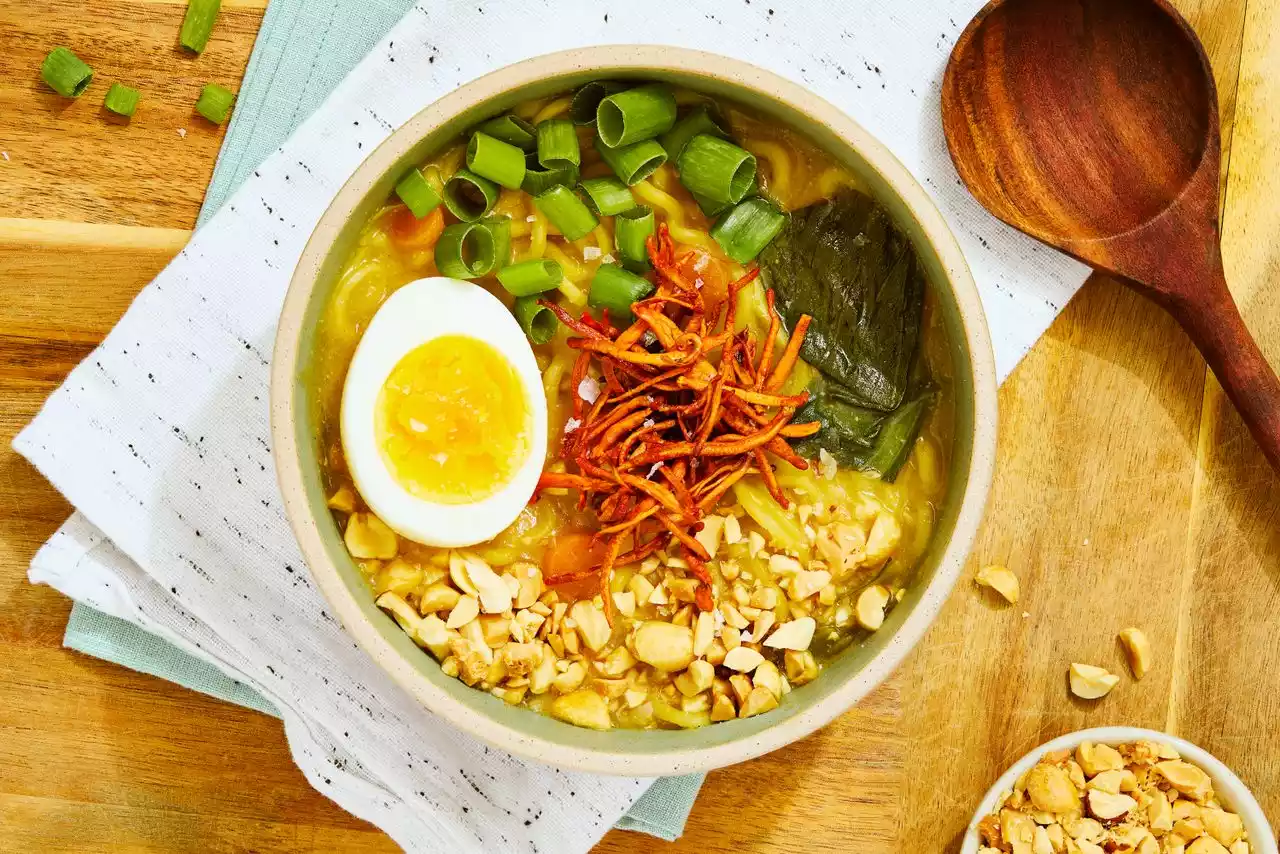
If you’re interested in incorporating cordyceps into your diet, here are some methods to consider:
- Cordyceps Powder:
- Smoothies: Add a teaspoon of cordyceps powder to your favorite smoothie recipe.
- Tea: Mix cordyceps powder with hot water for a simple tea or add it to other herbal teas.
- Soups and Stews: Add a small amount of cordyceps powder to soups and stews while they are cooking.
- Cordyceps Capsules:
- Some people find it easier to take cordyceps in capsule form. Follow the recommended dosage on the label.
- Cordyceps Tincture:
- This is a liquid extract of cordyceps. You can add a few drops to water, juice, tea, or even directly under the tongue. Always follow the dosage instructions.
- Whole Dried Cordyceps:
- Broths: Add whole dried cordyceps to broths and allow it to simmer.
- Stir-fries: Rehydrate dried cordyceps by soaking them in water for a few hours and then add them to stir-fries.
- Cordyceps Coffee:
- Some brands offer coffee blends that contain cordyceps. It’s a convenient way for coffee lovers to incorporate the mushroom into their daily routine.
- Incorporate into Baked Goods:
- Cordyceps powder can be added to muffins, cookies, breads, and other baked goods for a nutritional boost.
- Energy Bars and Snacks:
- Some health food brands offer snacks and energy bars with cordyceps included as an ingredient.
Tips:
- Start with a small dose to see how your body reacts and then gradually increase as needed.
- Always purchase from a reputable source to ensure you’re getting a quality product.
- Consult with a healthcare professional or nutritionist before adding any new supplement to your diet, especially if you are pregnant, nursing, or taking medications.
Incorporating cordyceps into your diet can be an interesting way to explore its potential health benefits. As always, it’s crucial to listen to your body and adjust intake based on how you feel.
Side Effects and Precautions
Cordyceps is generally considered safe for most people when taken in recommended amounts. Like any supplement or food, some individuals might experience side effects, there are a few precautions to keep in mind:
Side Effects:
- Gastrointestinal Issues: Some people may experience diarrhea, nausea, or abdominal discomfort when consuming cordyceps.
- Dry Mouth or Throat: Some individuals have reported feeling dryness in the mouth or throat.
- Mild Skin Itching: Rare, but some people might experience a mild itching.
- Allergic Reactions: As with any substance, there’s always a risk of an allergic reaction. Symptoms could include itching, rash, wheezing, and swelling.
- Bleeding: There are reports suggesting that very high doses of cordyceps might make it more difficult for blood to clot. This can raise the risk of bleeding in people with bleeding disorders or those taking anticoagulant medications.
Precautions:
- Pregnancy and Breastfeeding: The safety of cordyceps during pregnancy and breastfeeding is not well-established. It’s recommended to avoid use or consult with a healthcare professional.
- Autoimmune Diseases: Cordyceps can stimulate the immune system, which might increase symptoms of autoimmune diseases. Individuals with conditions like lupus, multiple sclerosis, or rheumatoid arthritis should exercise caution.
- Bleeding Disorders: People with bleeding disorders or those taking anticoagulant medications should be cautious because of the potential increased risk of bleeding.
- Surgery: Due to the potential effect on blood clotting, it’s advisable to stop taking cordyceps at least two weeks before scheduled surgery.
- Hormone-sensitive Conditions: There’s some evidence that cordyceps might influence testosterone and estrogen levels. People with hormone-sensitive conditions, such as breast cancer, uterine fibroids, or endometriosis, should approach cordyceps with caution and preferably under guidance from a medical professional.
- Interactions with Medications: Cordyceps may interfere with immunosuppressive drugs, anticoagulant/antiplatelet drugs, and certain antihypertensive medications. It’s essential to consult with a healthcare professional if you’re taking any medications.
- Source of Cordyceps: Ensure that you’re purchasing from a reputable source. Some cordyceps, especially wild ones, can be very expensive and might be adulterated with other substances.
Remember, while many people tout the benefits of cordyceps, individual reactions can vary.
Conclusion
Cordyceps Militaris and Cordyceps Sinensis are both fungal species renowned for their medicinal properties, especially in traditional Chinese medicine. These fungi have been used for centuries to boost energy, increase stamina, and improve overall health. Recent scientific studies have begun to validate some of these claims, suggesting potential benefits in enhancing immune function, exhibiting anti-tumor properties, and improving respiratory and kidney functions.
While both species share several therapeutic properties, Cordyceps Sinensis primarily grows on caterpillar larvae in the wild, making it rarer and more expensive, while Cordyceps Militaris can be more readily cultivated. As with any supplement or remedy, it’s important to consult with healthcare professionals and rely on evidence-based information when considering their use.

